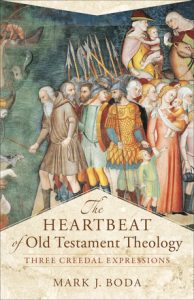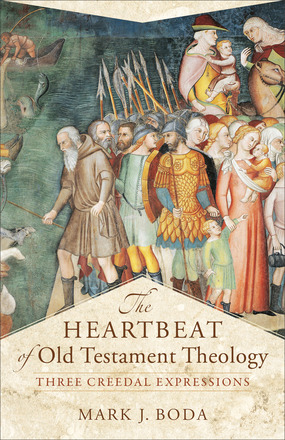Boda, Mark J. The Heartbeat of Old Testament Theology: Three Creedal Expressions. Grand Rapids, Mi.: Baker Academic, 2017, pp. 220, $22.99, paperback.
Mark Boda holds a Ph.D. from the University of Cambridge and is professor of Old Testament at McMaster Divinity College in Ontario, Canada. Dr. Boda is the author of numerous articles and books, including reputable commentaries on Judges, 1-2 Chronicles, Haggai and Zechariah, and several independent volumes on Zechariah. He has also published “Return To Me”: A Biblical Theology of Repentance (2015) in the New Studies in Biblical Theology series edited by D.A. Carson. In addition to his duties at McMaster, Dr. Boda is a seasoned evangelical minister and itinerant preacher who has served in various pastoral, missionary, and consulting positions.
Chapter one argues that an over focus on the diversity of the Old Testament (OT) in late twentieth-century scholarship has led to a loss of the OT’s essential unity (p. 6). Boda submits that the core of OT theology is located within three rhythms of the OT: the narrative, character, and relational rhythms.
According to chapter one, the narrative rhythm of the OT is found in the multiple historical summaries (Deut 6:21-23; 26:5-9; 24:2-13; Ps 78; Neh 9) that recite “the history of God’s redemption through finite action, that is, particular acts within specific times of history” (p. 15). While the elements differ from text to text, the central historical actions of God are “exodus and conquest” (p. 16). Together, the elements “form a single story” (p. 23) that is repeated across multiple texts and thus “binds together the historical experience” of God’s people (p. 23).
The character rhythm of the OT, developed in chapter three, is “expressed as God’s redemptive character, described through consistent activity utilizing nonperfective/nonpreterite verbal forms … as well as personal attributes utilizing adjectives and nouns” (p. 29). The “foundational example [is] in Exod. 34:6-7” (p. 29). The “character creed” declares “Yahweh’s typical redemptive activity in relation to his people” with a “focus on God’s steadfast love, which entails forgiveness but also justice … [which] point to his key characteristics of mercy and holiness” (p. 49).
The relational rhythm is explored in chapter four and begins with the “copular syntactical construction”: “I will be God for you and you shall be a people for me” (p. 54-55). This foundational phrase is regularly located within covenant texts that appear at pivotal moments of redemptive history. Boda argues that “‘covenant’ is not the relationship itself [between God and his people] but rather an agreement that articulates the nature of the relationship and structures it” (p. 60). A berît בְּרִית)) is thus “an elected … relationship of obligation” (p. 61) that includes reciprocity, identity and responsibility (cf. Deut 26:16-19; Gen 17:1-15; Num 18; 1 Kgs 3:9; etc.) (p. 63).
Chapter five shows these three rhythms in concert together in Exodus 5:22-6:8 and Nehemiah 9. Chapter six relates the goal of these three creedal rhythms with the goal of redemption: the transformation of creation and the cosmos. Chapter seven demonstrates that these three rhythms continue into the New Testament while chapters eight and nine apply the three creeds to the Christian life.
Boda employs a careful methodology that is textually/Scripturally grounded, sensitive to the progress of revelation and the canonical context, and cognizant of current discussion in OT scholarship. Boda is pursuing the “core theology of the OT” through the theological hermeneutic of Biblical Theology (p. xiv). He terms his methodology a “selective-intertextual-canonical approach” (p. 7). He thus selects texts that “constitute its ‘inner structure’” by paying attention to intertextual rhythms that focus on “repeated use of particular phrases, expressions, and structures throughout the breadth of the OT and NT” (p. 7). The end of the book includes an appendix (pp. 151-182) that provides a robust overview and defense of the history and methods of Biblical Theology. As a whole, Boda’s methodology both explains and exemplifies the task of contemporary evangelical Biblical Theology.
While he does not use these words, Boda argues effectively that the center or “heartbeat” of the OT is located within these three rhythms of the OT. He rightly relates these three rhythms to the overall goal of redemption: creation and the cosmos. Boda shows how God’s creational activity is often the foundation for his redemptive activity, especially in the Psalter, the wider wisdom literature, and the prophetic literature: “the redemptive agreements with Israel were part of a much larger story of redemption that would impact not just all nations (Gen. 10) but also all creation” (p. 100).
The pursuit of a center in Biblical Theology has occupied scholarship for several decades. The search for a center has itself led to an overly narrow focus on particular themes or motifs within the OT. While various scholars may argue that the presence of God, the glory of God, the kingship of God, or the kingdom of God are at the center or a part of the center of OT theology, Boda’s three rhythms do indeed represent the heartbeat of OT theology. Any OT theology that is attempting to genuinely represent the OT scriptures as they present themselves must deal with the ubiquitous references back to Exodus 34:6-7, the multiple narrative summaries of Israel’s history, or the many covenantal texts that lie at pivotal moments in OT redemptive history. Boda’s three rhythms serve to summarize the message of the OT simply, within Scripture’s own categories, and with actual Scriptural language. Further, Boda shows multiple passages in which these three rhythms are woven together into a coherent theological statement contextualized within the history of Israel (cf. Exod 5:22-6:8 and Neh 9). The result is a thoroughly biblical description of OT theology.
Boda is careful to show how these three rhythms of the OT’s heartbeat make our own hearts beat for the Lord. For example, his call to evangelicals to not lose the essential narrative story of the Bible is a helpful corrective to pastors and scholars alike who may stop with historical-grammatical exegesis and not connect the larger canonical dots. His other applications have a similar poignant and convicting call (p. 123). The character rhythm compels us to develop a spirituality that worships and regularly pursues relationship with a strikingly personal God who works miraculously in the present (pp.. 130-133). The relational creed calls us to focus on biblical conceptions of covenant that emphasize relationship instead of extra-biblical covenantal systems.
Boda’s consistent interaction with the non-evangelical guild of OT scholarship shows an appreciation for their work and a sincere effort to recognize their contribution. However, the absence of interaction with recent key evangelical authors within the field of Biblical Theology is surprising. Interaction with the likes of Kaiser, Hamilton, Schreiner, Sailhamer, Gentry, Wellum, Alexander, Hafemann, and perhaps most surprisingly, C. J. H. Wright, are essentially missing except in footnotes. By leaving these evangelical authors out, one wonders how Boda’s argument complements and corroborates the most recent work done within evangelical Biblical Theology. Notwithstanding, Boda makes an important contribution to OT theology that is concise, exegetically sound, pastorally sensitive, and useful to scholars, students, and lay believers alike. I heartily recommend this work.
C. Randall Breland
The Southern Baptist Theological Seminary
and Arlington Baptist College





